‘Deadpool & Wolverine’: The 10 Best Comic Book Runs To Read After Watching Marvel’s Mutant Crossover
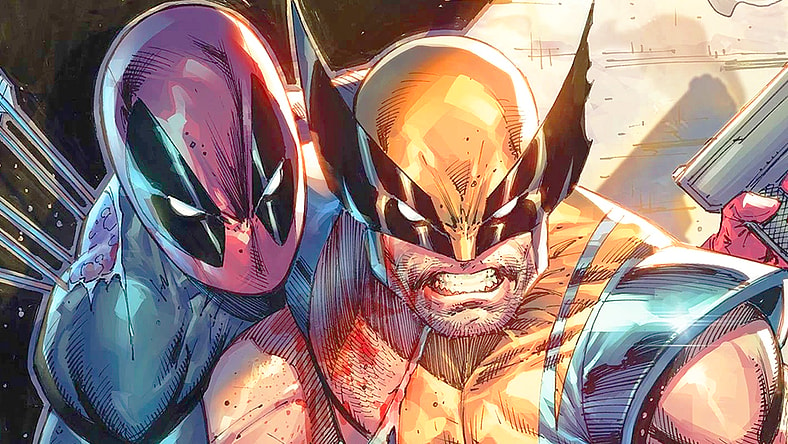
I’m just as surprised as you are given the MCU’s recent track record, but Deadpool & Wolverine was pretty good, huh?
Between its heartfelt character work, bloody action scenes, and deep-cutting fan-service (which some audiences may have understandably rolled their eyes at, but I particularly enjoyed), Wade and Logan’s Wild Ride delivered ‘fun’ in a way that most superhero films in recent memory have just been unable and unwilling to do.

RELATED: ‘Deadpool & Wolverine’ Review – The MCU Feels Relevant Again
The reasons for the film’s ‘fun’ are many, ranging from its abandoning of typical MCU tropes, to its lack of sociopolitical grandstanding, to its willingness to actually show audiences what are happening in its fight scenes, but one of if not perhaps the most significant factor in its ability to entertain audiences is its genuine respect for its various source materials.
(I know, shocking concept, right?)

After seeing Deadpool & Wolverine treat both Marvel’s cinematic and comic book histories treated with such unironic respect and adulation, some audiences will no doubt want to delve into the various works that informed the film’s narrative.
And while it’s relatively easy to explore the former – in total, only 17 films were produced based on Marvel Comics characters prior to the start of the MCU – the latter’s expansive nature makes it a bit more daunting to approach.
As such, rather than diving in to the deep end without knowing how to swim, allow me, a veteran comic book reader, to help you Wade (Wilson) your way in to the (Dead)pool.
To that end, I present to you, interested reader, ‘The 10 Best Comic Book Runs To Read For More Deadpool & Wolverine‘.

10. The Merc With A Mouth Vs. The Mutant Berserker (Wolverine Vol. 2 #88 / Deadpool Vol. 3 #27 / Wolverine Annual 1999 / Wolverine Vol. 2 #154-155)
You can’t have a list of post-Deadpool & Wolverine reading recommendations and not include the two bosom buddies’ first meeting – as well as a few of the more bloody ones they’ve had thereafter.
The seeds of conflict between the two Weapon X alumni were first planted by writer Lara Hama and artist Adam Kubert in 1994’s Wolverine Vol. 2 #88, wherein Logan and Wade would have their premiere encounter as a result of the book’s title character stepping in to stop The Merc With A Mouth from killing his ex-girlfriend, the mutant shapeshifter Vanessa Carlysle, in a jealous rage.
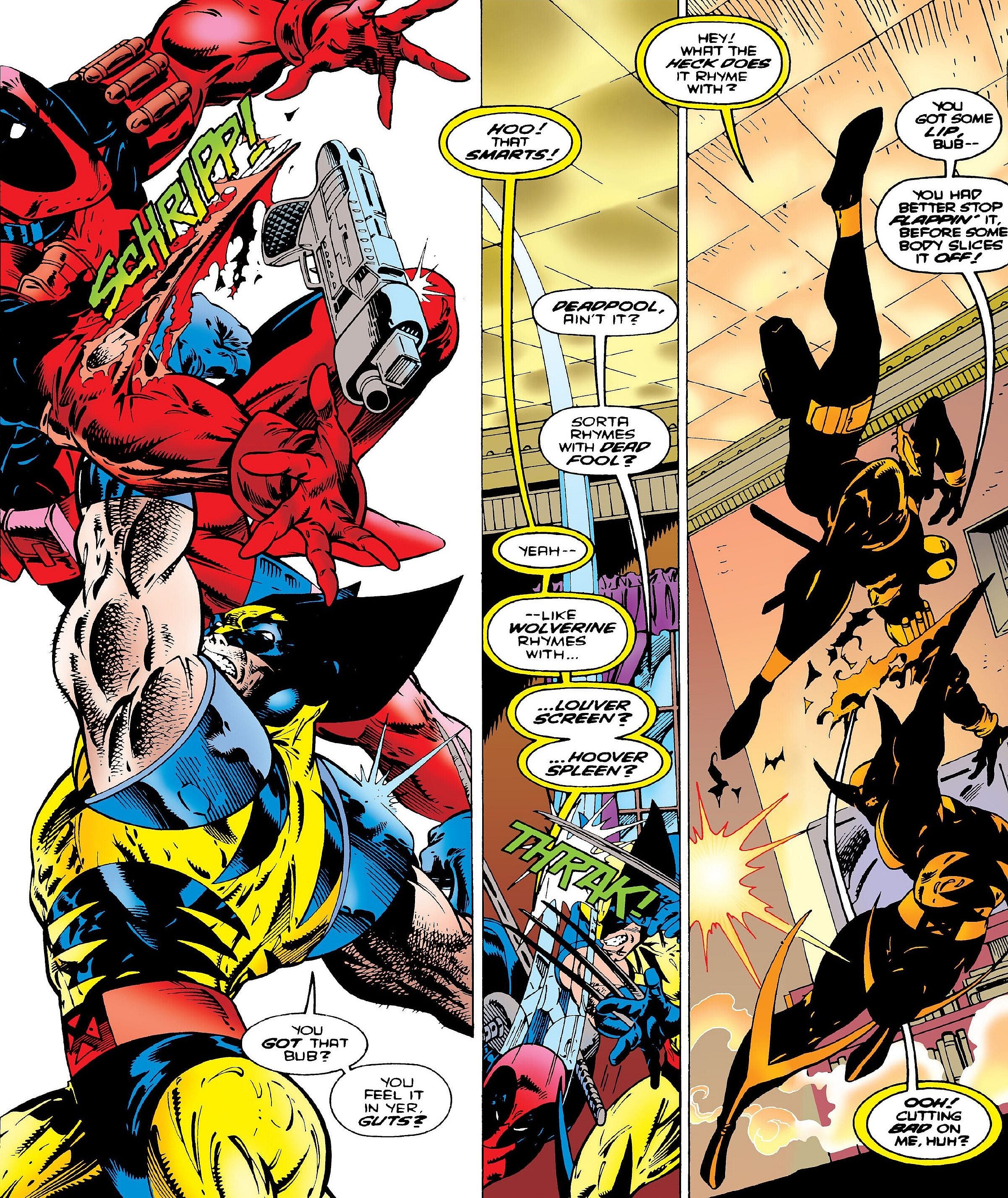
Successfully fending off the madman, Wolverine would come to blows with Deadpool a number of times in the years that followed, the reasons for their occasional brawls ranging from a supervillain’s machinations (Deadpool Vol. 3 #27), to their own egos (Wolverine Annual 1999), to outright backstabbing (Wolverine Vol. 2 #154-155).
Admittedly, as these fights last for only a few pages at best and rarely if ever have any lasting effect on the pair’s on-again-off-again frenemy status, these stories are perhaps the least consequential to either character’s overall histories of any on the list.
But hey, that doesn’t mean they’re not entertaining.
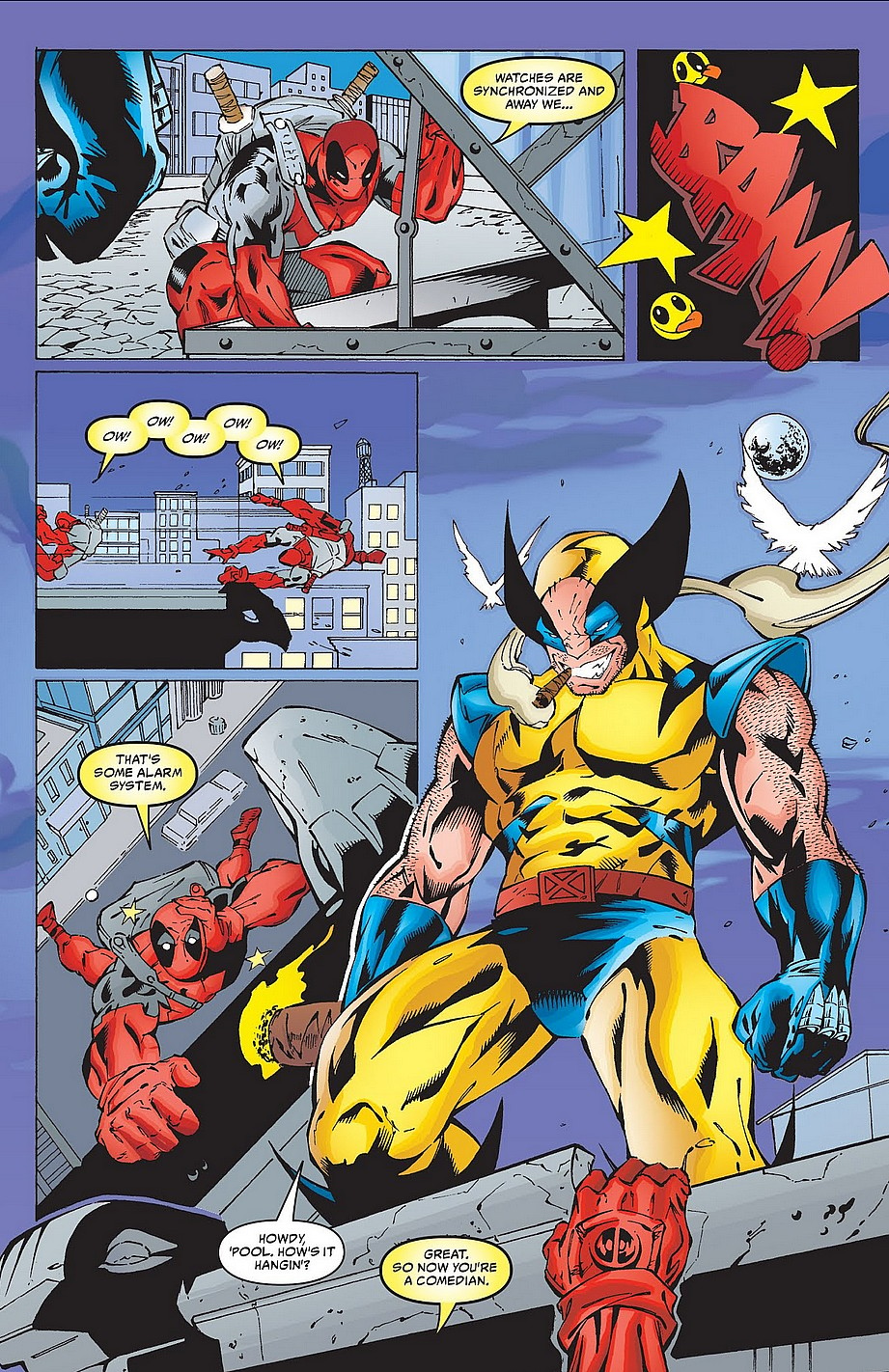
9. The Deadpool Corps Assemble (Prelude to Deadpool Corps Vol. 1 (2010)) / (Deadpool Corps Vol. 1 (2010))
The central antagonists of the film’s riff on Oldboy‘s hallway fight scene, despite being portrayed on screen as Wade and Logan’s enemies, the Deadpool Corps were originally introduced in the comics as allies to their Earth-616 namesake.
Consisting of Ladypool, Kidpool, Headpool, and Dogpool, the Corps were assembled by the Prime Deadpool to stop a primordial entity known as The Awareness from consuming the entire Marvel Multiverse, their deranged minds rendering them immune from the villain’s ability to eat the very concept of ‘consciousness’.
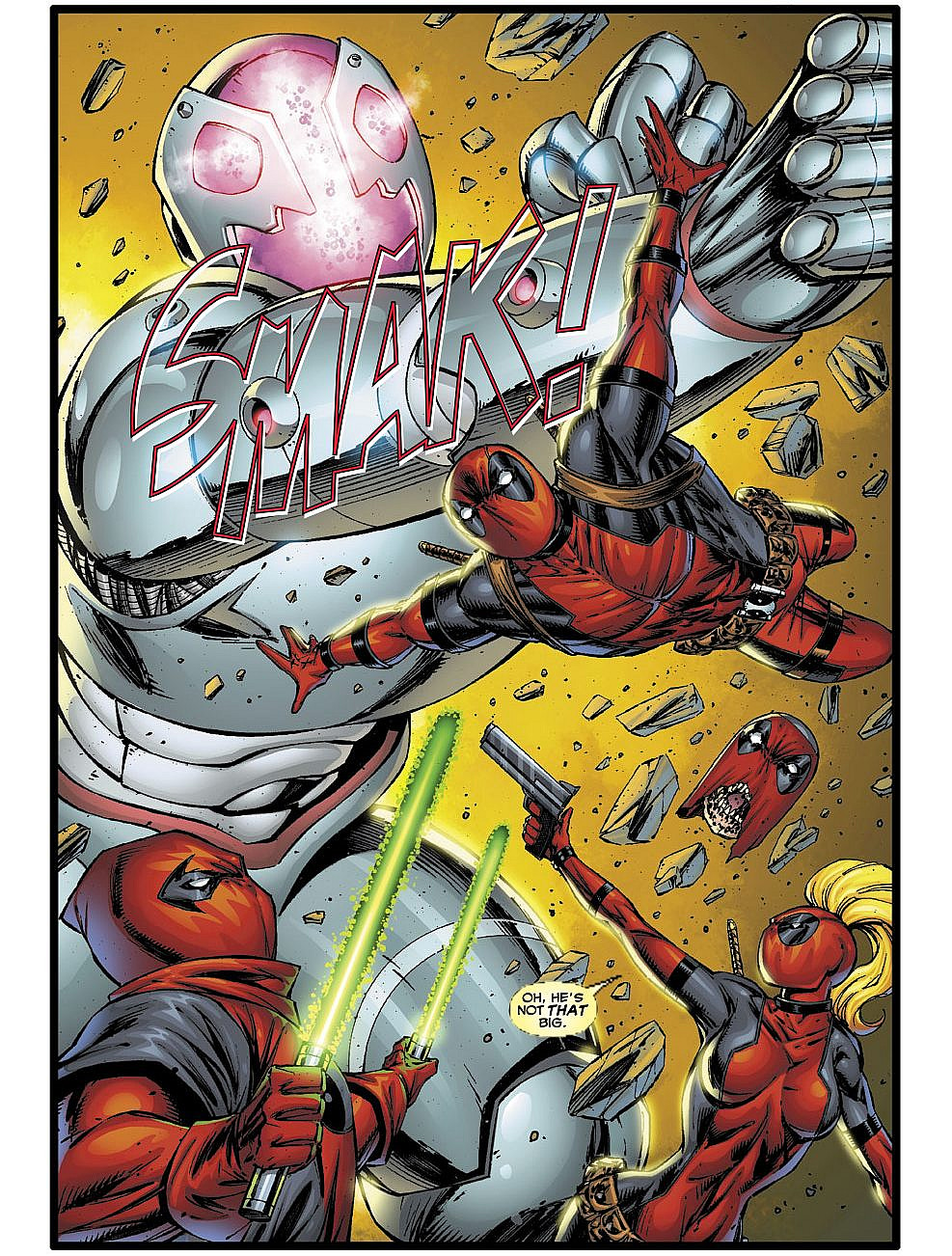
Written by Victor Gischler and featuring artwork from a variety of artists including Paco Medina, Phillip Bond, Whilce Portacio, and Deadpool creator Rob Liefeld himself, these first two Deadpool Corps mini-series tell the tale of the team’s origin and their first (and arguably only successful) mission together.
Far from the strongest series on this list – both series feature a heavily Flanderized interpretation of The Merc With A Mouth’s fourth-wall breaking character – for anyone wanting to see more alternate Deadpools, as well as the beginning of Wade’s consideration as ‘Marvel Jesus’, this is the best place to start.
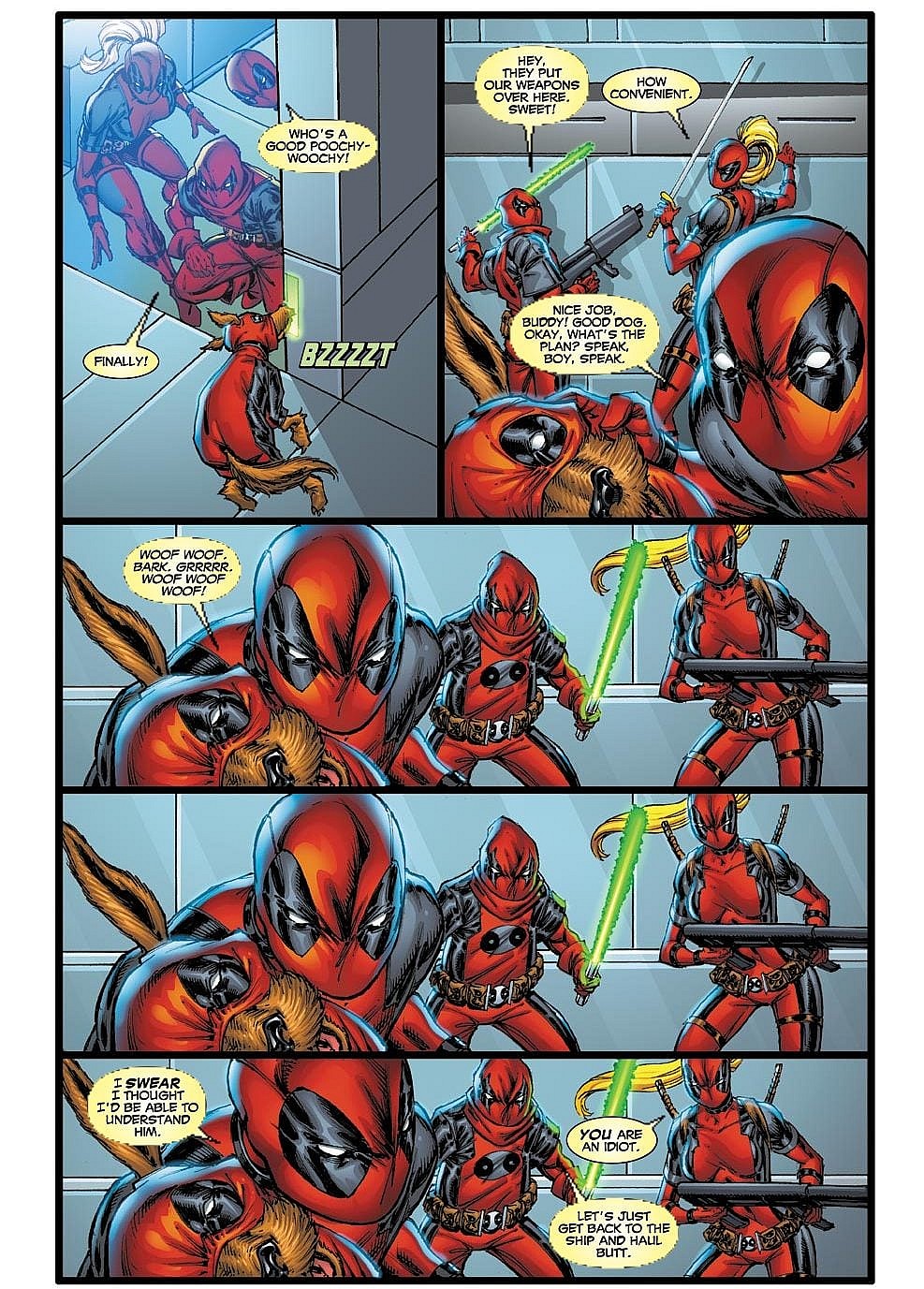
8. Old Man Logan Takes (Wolverine Vol. 3 #66-72, Wolverine: Old Man Logan Giant-Size Vol. 1 #1)
From the moment Wade makes the acquaintance of the version of Logan that eventually serves as the film’s deuteragonist, it’s very clear that something is off about the mutant hero.
Eventually, it’s discovered that unlike most of his other variants, this Logan not only lost his friends and family at the Xavier’s School for Gifted Youngsters to an anti-mutant hate mob, but responded to their deaths by massacring humans left and right.
All in all, a pretty bleak reality.
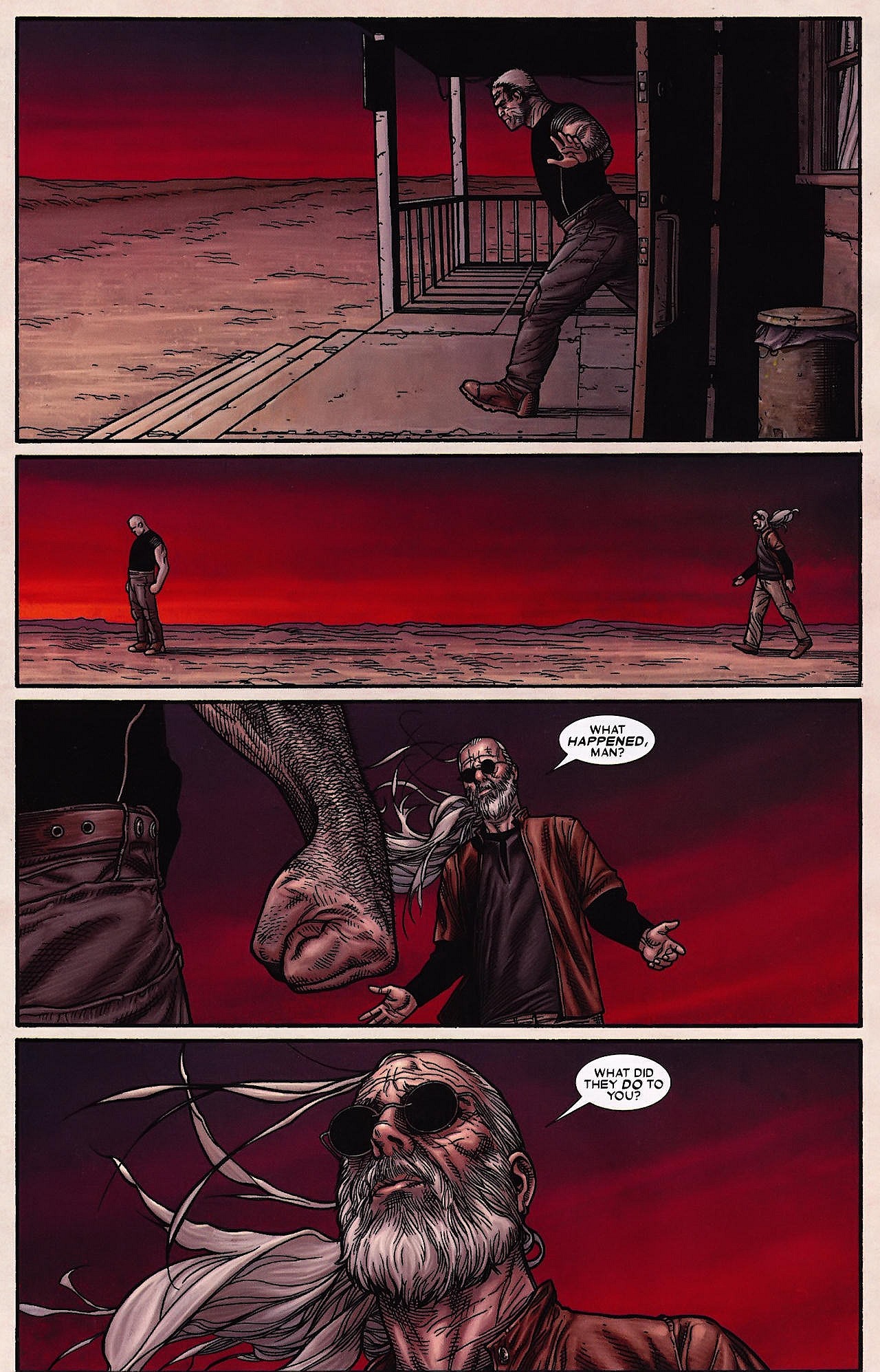
But rather than being a generic attempt at ‘deconstructing a hero’, this interpretation of Logan is actually heavily inspired by his portrayal in author Mark Millar and artist Steve McNiven’s fan-favorite ‘Old Man Logan’ storyline.
Essentially a ‘What If…?’ tale contained within the pages of Wolverine’s solo book, the Mark Millar penned and Steve McNiven illustrated story finds the titular mutant as one of the few living heroes left on Earth following a full-on assault on their ranks by a united front of villains.

However, rather than continuing to fight the good fight, Logan has instead given up on his entire heroic past, his mind haunted by the fact that he was tricked by Mysterio’s illusory powers into massacring his fellow X-Men during the aforementioned battle.
Of course, the legend of Logan never dies, and eventually, like his movie counterpart, Old Man Logan is eventually pulled back into the fray by a smart-mouthed hero – Deadpool in the film, Hawkeye in this storyline seeking to take back the world from its villainous overlords.
Given how major of an influence the storyline was on Deadpool & Wolverine, Old Man Logan is a good place to start for any fan looking for a familiar place to jump into the comic books.
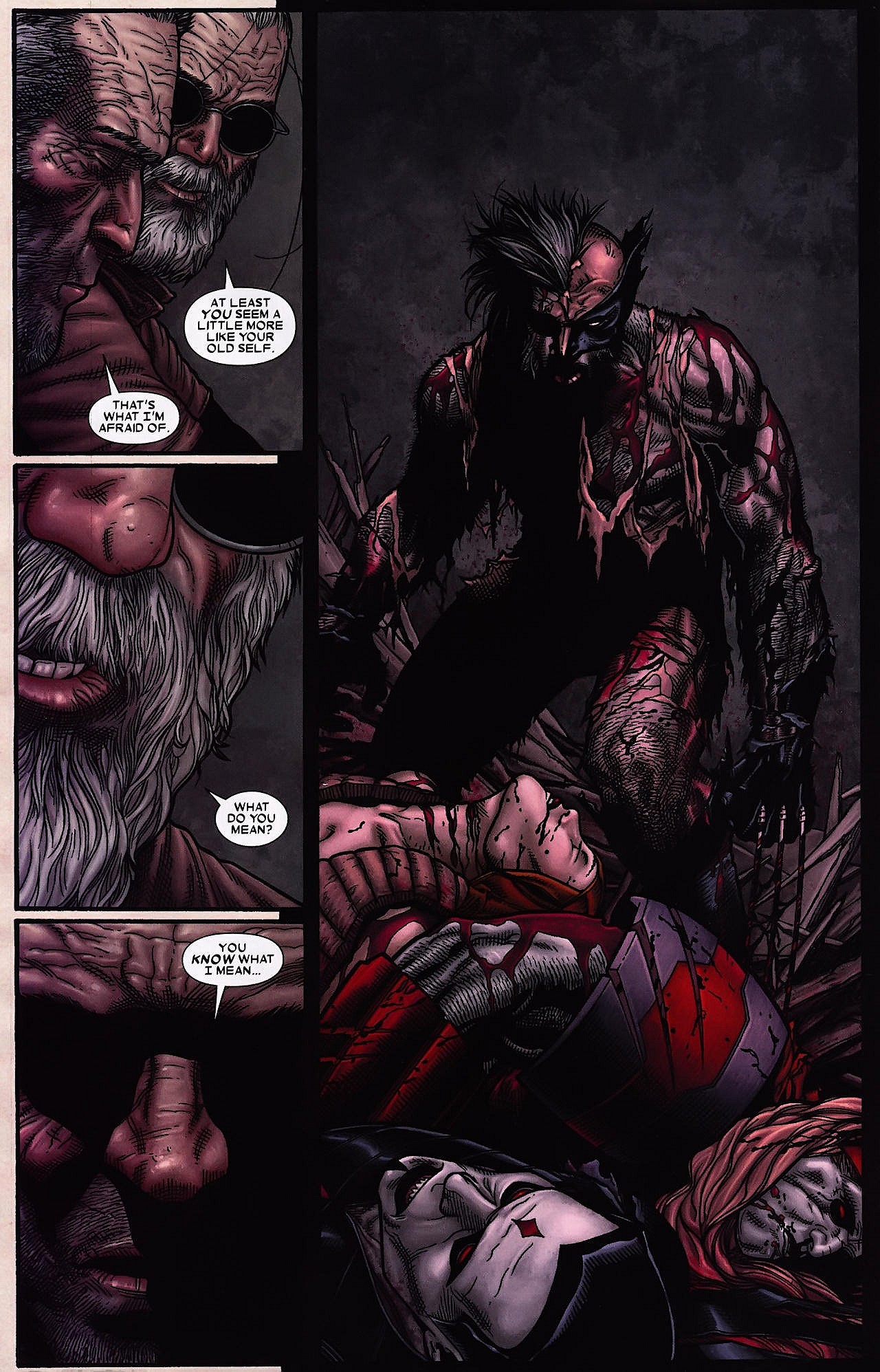
7. The Saga Of Cassandra Nova (New X-Men (2002) Vol. 2 #113-#126)
She’s bald, she’s bad, and she’s one of the most powerful mutants to ever live.
Ladies and gentlemen, lets talk about Cassandra Nova.
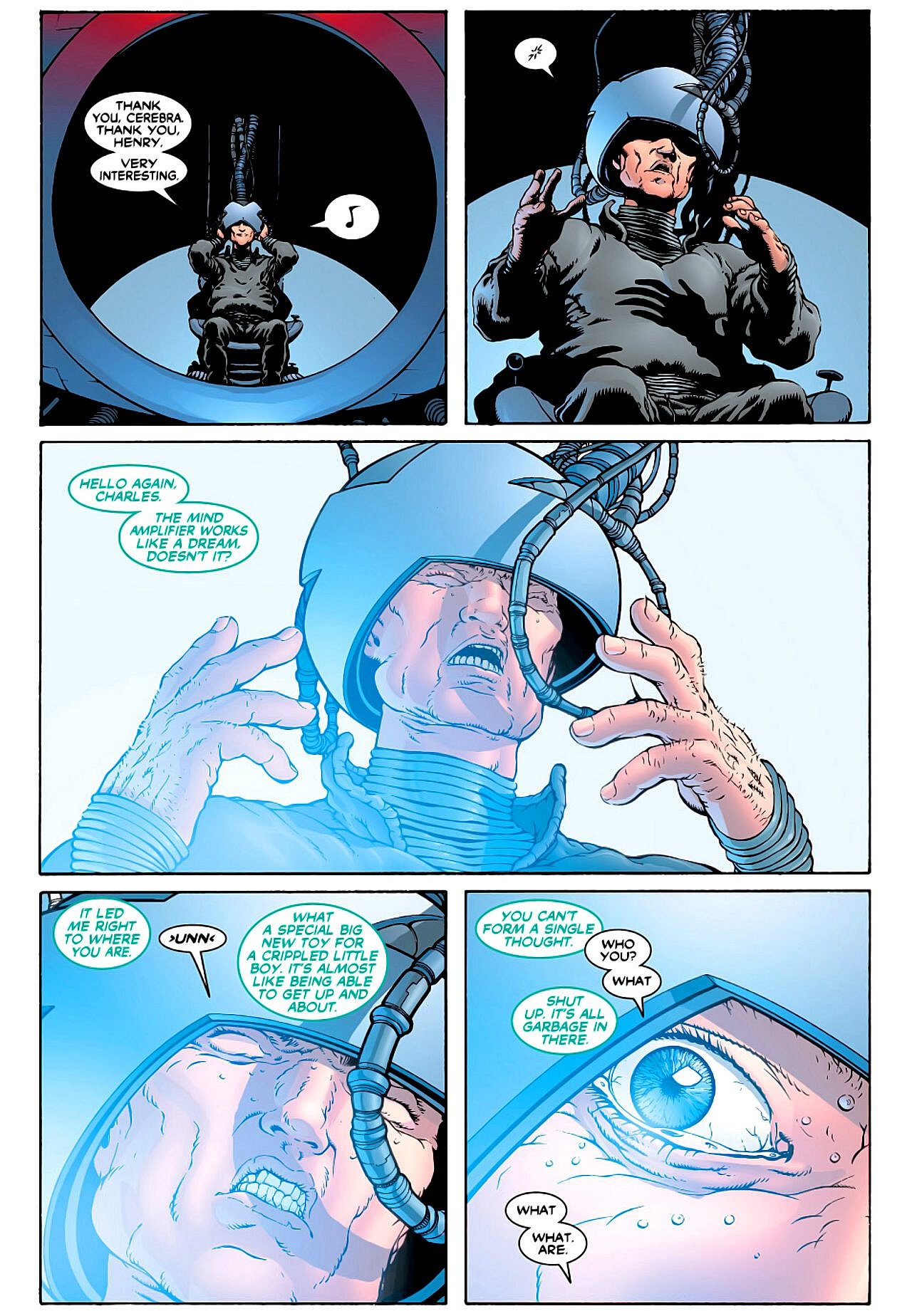
The film’s main antagonist and twin-sister of Charles Xavier, Nova was banished to the Void at the time of her birth due to the TVA’s fear of her Omega-level telekinetic and telepathic powers, which she now uses to rule over the inhabitants of the ‘garbage dump’ dimension with an iron fist (or mind, rather).
However, despite being related to the very founder of the X-Men, even die-hard X-fans may be unfamiliar with Nova’s existence.

The reason for this is two-fold: Not only is she far too powerful to be used as a consistent narrative threat to Marvel’s Merry Band of Mutants (as seen in Deadpool & Wolverine), but her origin is so absolutely off the wall that ever since it was explained, the publisher has done its best to avoid addressing the subject all together.
Featuring alien spirits, an attempt to murder Charles in their mother’s womb, and a handful of decades spent as a clump of cells incubating in the sewers, those interested in learning more about Nova – as well as seeing her handing the X-Men one of their biggest losses of all time – would do best to just go straight to the source and check out her debut in writer Grant Morrison and artist Frank Quitely’s iconic run on New X-Men Vol. 2.
(And while the issues recommended here are specifically those that deal with Nova’s story, I would recommend that readers looking for similarly ‘cerebral’ X-Men stories check out the entirety of Morrison and Quitely’s run, which ultimately comes to an end with the series’ 155th issue.)
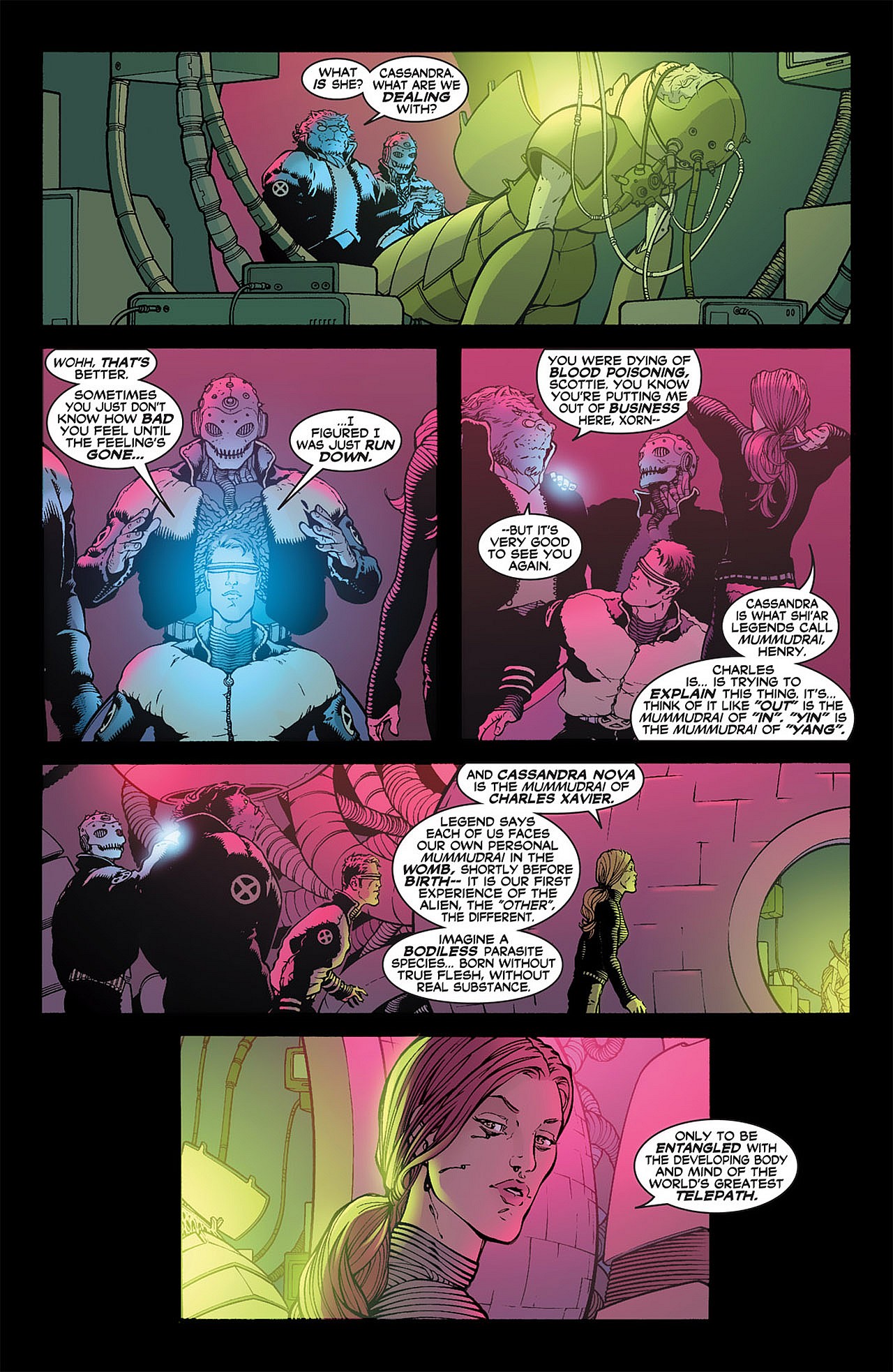
6. Heavy Is The Head That Kills The Crown (Uncanny X-Force Vol. 1 (2010))
Let’s cut to the chase: When one sees Deadpool and Wolverine are set to share the stage, one thing they’re going to expect is violence. Lots and lots of violence – some of it necessary, some of it more than gratuitous.
The film delivered this in spades: From Deadpool’s opening dance with Logan’s corpse, to the pair’s Honda Odyssey-set brawl, to their aforementioned run against the Deadpool Corps, the two mutants both got their chance to let their blades shine.
In the comics, the pair’s strengths are similarly let loose within the pages of writer Rick Remender’s Uncanny X-Force Vol. 1.
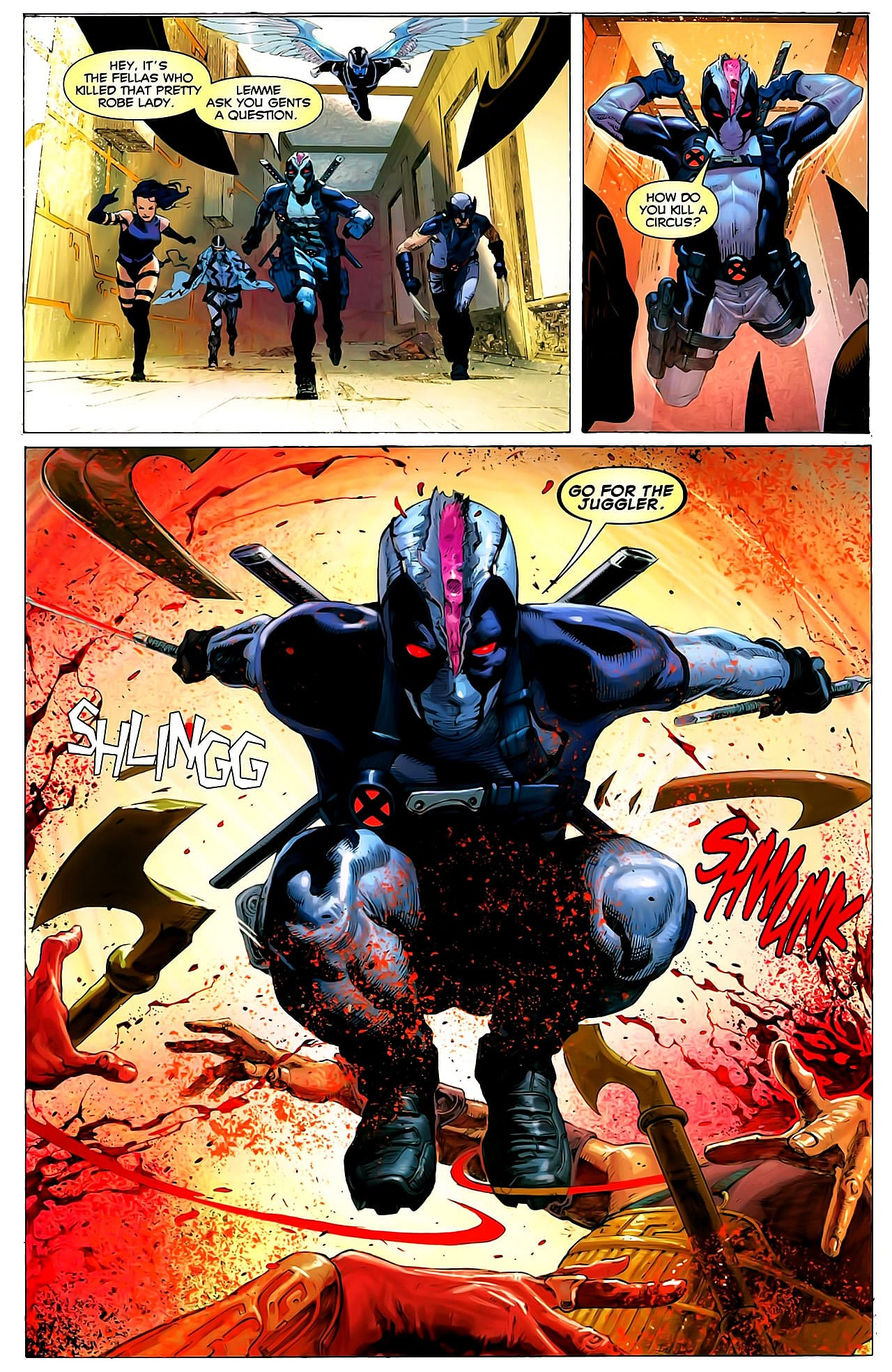
Centering on the titular Wolverine-assembled mutant strikeforce, this runs sees a rotating cast of mutantkind’s most ‘morally grey’ representatives – including Deadpool – tasked with doing the dirty black ops work needed to keep their species safe, whether that means laying waste to a newly formed team of anti-mutant Reavers or putting a bullet in the head of a newly-revived, child-aged Apocalypse before he can grow into his power.
However, far from just a B-movie gorefest put to paper, Remender’s work on Uncanny X-Force also features a tour de force of character work, its various arcs exploring the drastic toll the team’s work can take on one’s minds and moral, even among those who regularly find themselves staring down the worst that both humanity and mutantdom have to offer.
Plus, this team’s roster also features Psylocke. Can’t go wrong with that sort of line-up!
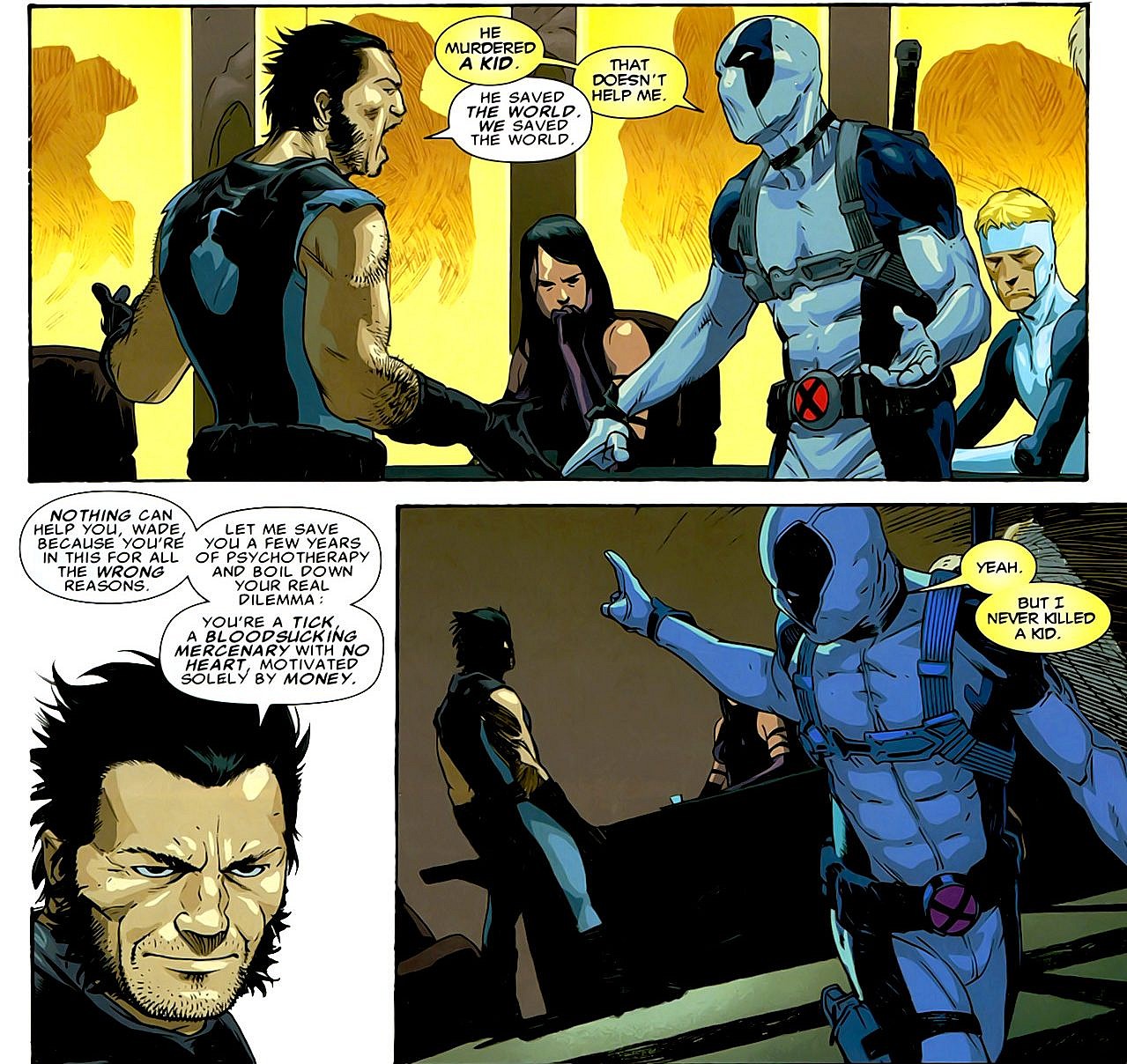
5. The Merc With A Mouth’s First Solo Series (Deadpool Vol. 3 #1-33)
After spotlighting almost every other member of the film’s cast, it’s only proper that we offer some attention to the Crimson Comedian.
Prior to his exhausting mid-2000s run as a tired, unfunny Reddit meme machine (a character assassination largely executed by the writer of the anti-hero’s 2008 solo book, Daniel Way), Deadpool was an actual character, his childish humor used to mask the deep pain he felt towards the loss of his memories and his permanent disfiguration, both keepsakes of his time in the Weapon X program.

His characterization as ‘tortured comedian’ was largely defined by writer Joe Kelly’s 37-issue run on Deadpool Vol. 3, wherein they took Fabian Niecza and Rob Liefeld’s blatant Deathstroke parody and turned him into one of the Marvel Universe’s most sympathetic characters.
Of course, their work was more than just heavy-handed and angsty character drama (after all, that’s what Spider-Man books are for!)
Serving as the anti-thesis to the dark and gritty comic book landscape of the 1990s, the pair’s roughly-four dozen issues of Deadpool Vol. 3 presented readers with a superhero-themed comedy-drama, its core narrative constantly seeing its protagonist torn between zany, slapstick antics and having his heart and soul ripped from his chest (sometimes literally) by one of his former Weapon X teammates.
If you’re looking to understand the very appeal of Deadpool as a character – as well as see the first appearance of Blind Al – this is the run you’ll want to crack open.
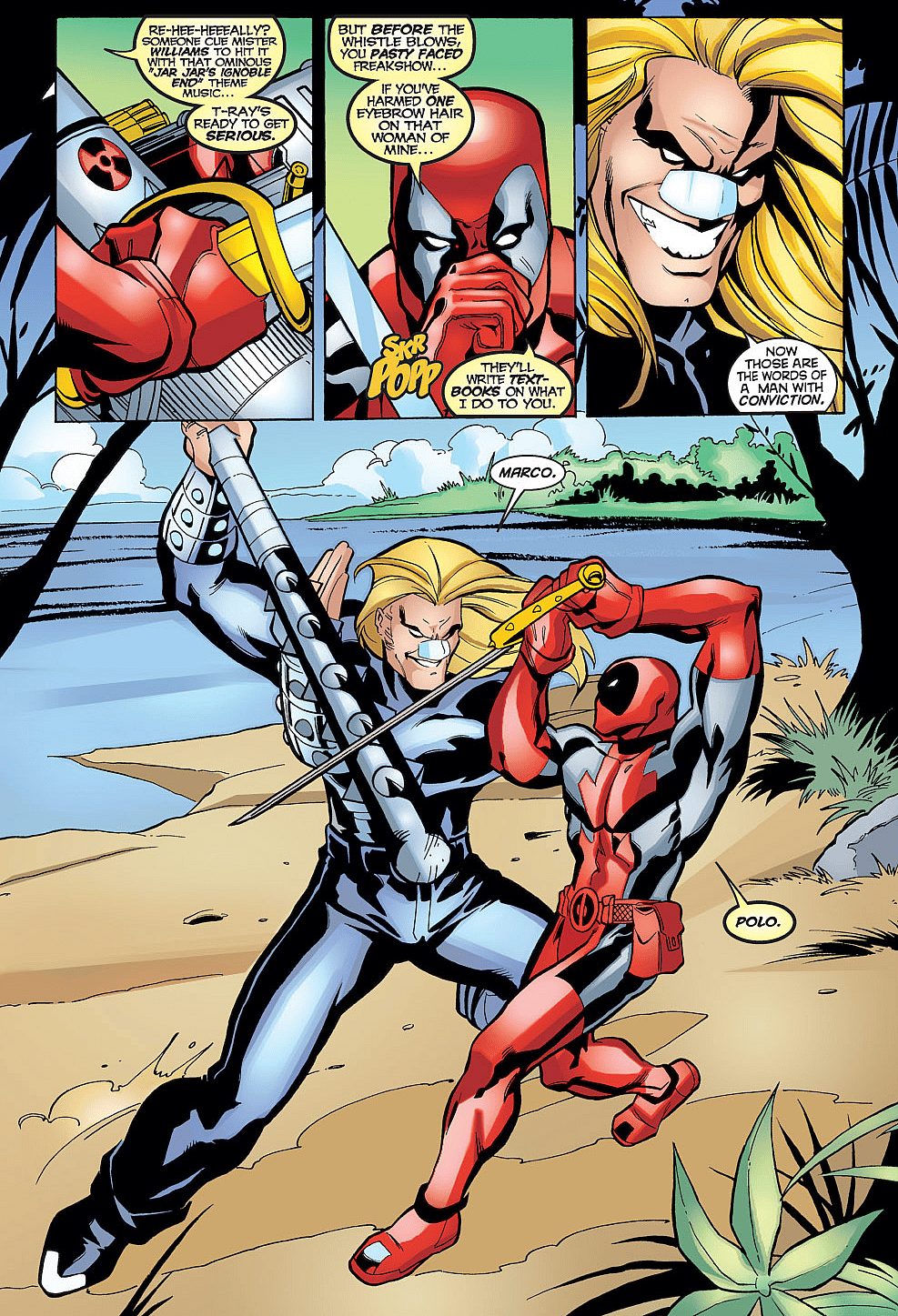
4. Another Fine Mess (Astonishing Spider-Man & Wolverine Vol. 1 (2010))
Sure, it may see Wolverine teaming up with a different red-suited, quick-witted Marvel hero, but Astonishing Spider-Man & Wolverine Vol. 1 comes highly recommended to anyone who enjoyed the buddy cop dynamic shared between Deadpool & Wolverine two leads
Coming from the mind of Jason Aaron (I know, I was just as surprised by that fact as you are) and the pencils of Adam Kubert, the 2010 mini-series sees the X-Man and the wall-crawler sent for a temporal ride after a collection of time-traveling diamonds banish them across the far reaches of time and space.
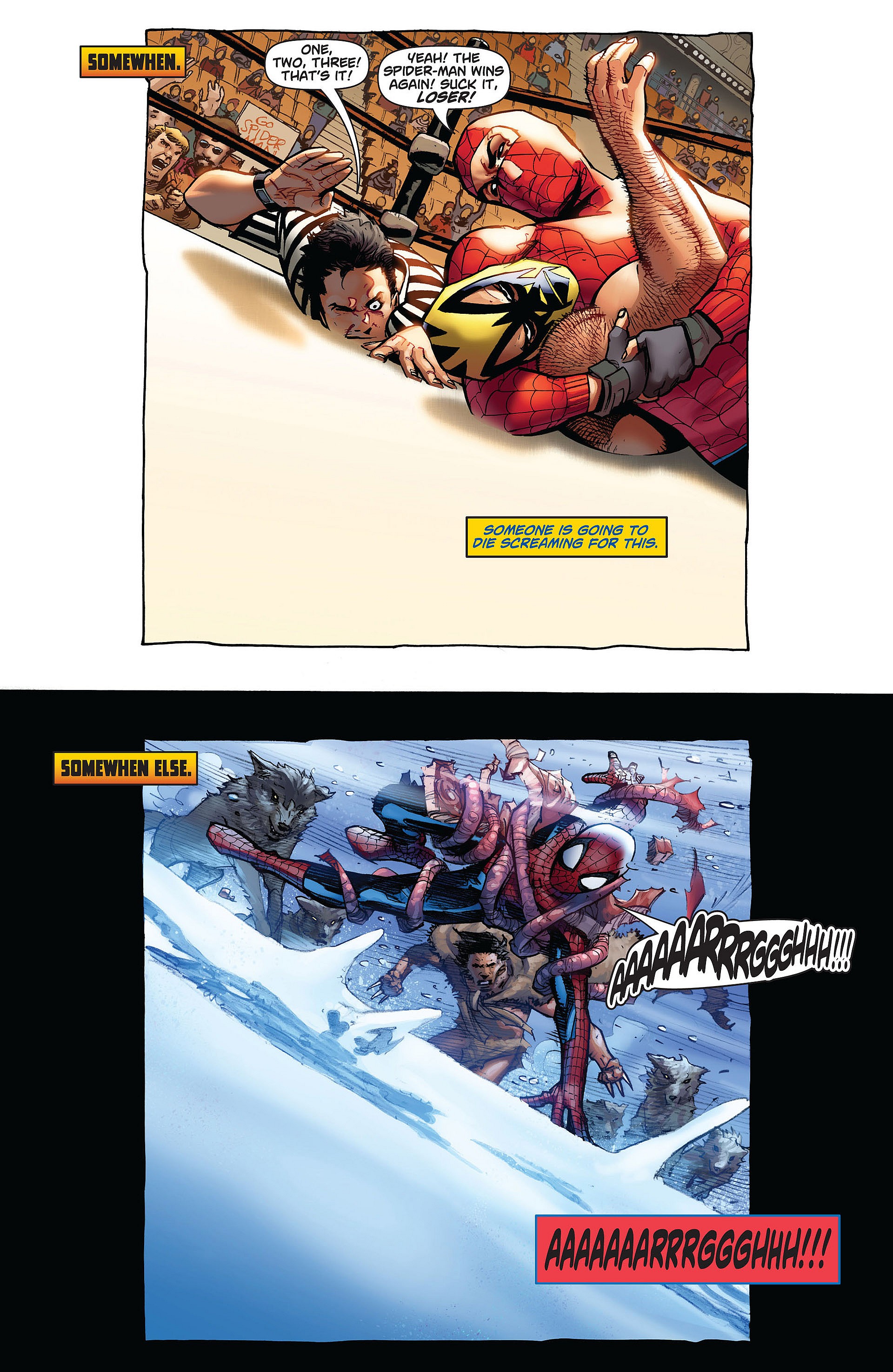
Trapped in the past and being constantly shunted through various points in history, the duo must work together not only to survive, but find a way to both get back home and strip their opponents of their temporal powers – a plan which, slight spoilers, involves them risking life and limb to harness the Phoenix Force.
Short, sweet, and the very definition of ‘comic book fun’, Astonishing Spider-Man & Wolverine may not feature any Deadpool, but it’s an easily accessible tale whose script feels almost like an early blueprint for Deadpool & Wolverine itself.
(And hey, given how much Deadpool’s modern characterization steals from Spider-Man’s ‘qwippy’ demeanor, if one squints their eyes while reading, they may not even see much of a difference.)

3. Cable & Deadpool Vol. 1 (2004)
So, that was a Wolverine team-up without Deadpool. Now, let’s talk about a Deadpool team-up without Wolverine.
Hitting shelves in 2004 following a brief editorial period where no one quite knew what to do what either character, Cable & Deadpool saw the latter hero’s co-creator Fabian Nicieza pair the two characters together as an Odd Couple-esque duo, with Cable serving as the series’ mutant messiah straight man and Deadpool as its morally-conflicted-about-his-best-friend’s-god-complex comedic relief.
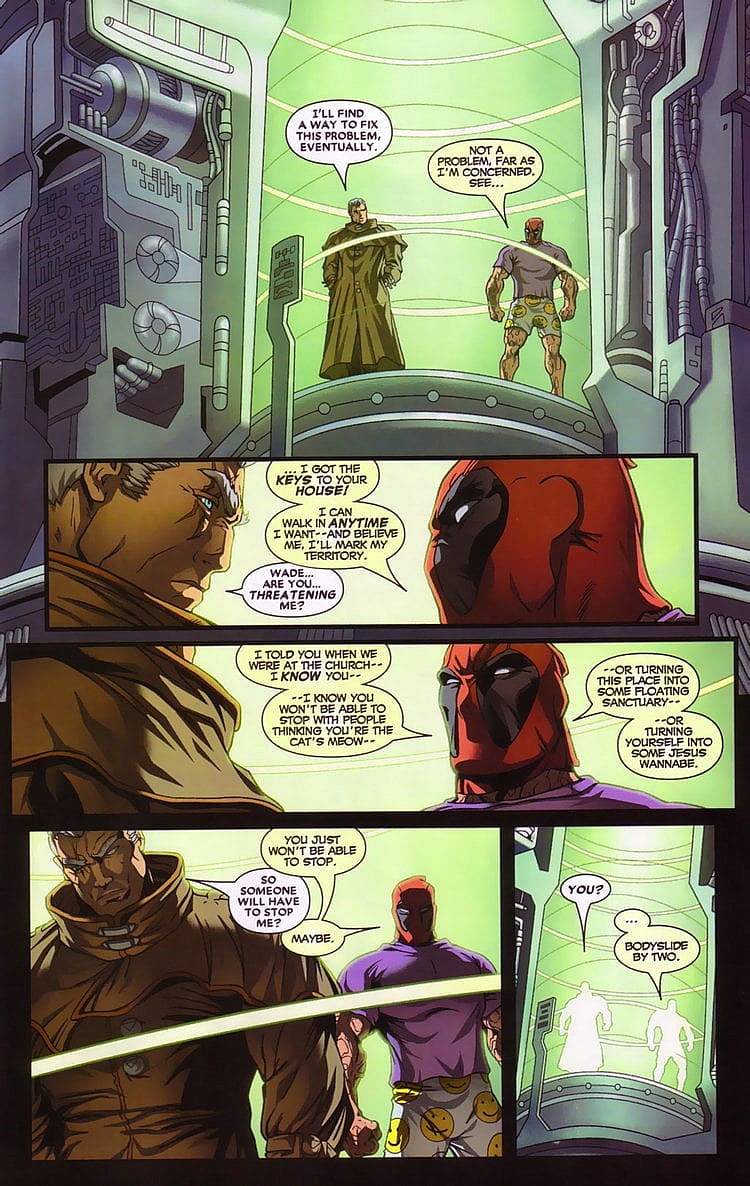
And in doing so, he delivered what is arguably is the most important run to Deadpool & Wolverine‘s entire existence.
His willingness to team-up with others, his deep-down desire to be a full blown member of Earth’s Mightiest Heroes rather than a simple killer, his finding a ‘family’ to fight for – all of these elements to Deadpool’s characters were practically to entirely non-existent prior to Cable & Deadpool.
Essentially, without Nicieza’s work on this run, the very essence of Deadpool & Wolverine‘s identity would be very, very different.
But aside from the run’s importance to the film, it’s just damn good comics, and damn good Deadpool ones at that.
From Deadpool being hired by Cable to serve as his own personal moral overwatch, to Deadpool having to take care of a baby-aged Cable, to finally putting an end to the Deadpool/T-Ray mystery (as seen in Deadpool Vol. 2!), every issue of Cable & Deadpool not only entertains, but gives readers reason to keep coming back for more.

2. The Good The Bad and The Ugly (Deadpool Vol. 5 #15-19)
I briefly mentioned it above, but it cannot be stressed enough just how much damage Marvel leaning into Daniel Way’s ‘Le Epic Meme Man’ depiction of Deadpool did to his character.
Thankfully, writing duo Gerry Duggan and Brian Poshen’s refreshing run on Deadpool Vol. 5 eventually brought some gravity back to his character, primarily by reintroducing the ‘tortured at heart’ side of Deadpool’s personality that had so well-defined Kelly’s run on Deadpool Vol. 2.
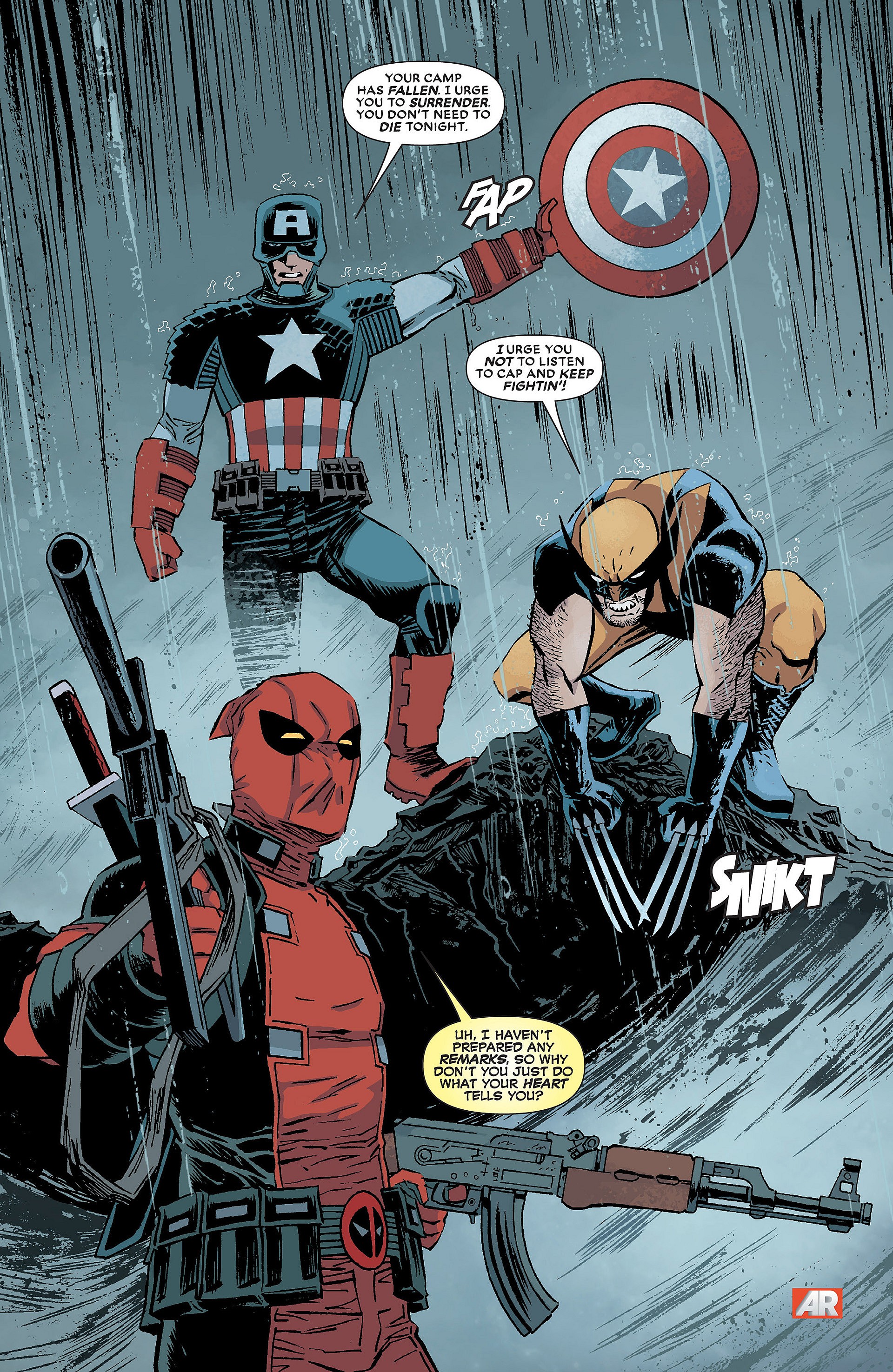
And perhaps no arc of their run exemplifies this return to tragic form than The Good, The Bad, and The Ugly.
Featuring artwork by Declan Shavlvey and Scott Koblish, this story kicks off when Deadpool, finding himself the target of a mysterious assassin hellbent on executing Weapon X alumni, reaches out to his fellow program graduates Wolverine and Captain America for help in putting an end to the threat – both for his own sake and the sake of his daughter, Ellie.
However, the trio soon discover that rather than just a simple hit job, Deadpool is being targeted specifically for his DNA, samples of which are being grafted by his pursuer onto North Korean concentration camp victims in order to turn them into cheap and disposable mutant supersoldiers.
And sadly, though the heroes are eventually successful in putting an end to the villain’s schemes, they do not do so without coming face to face with some of the worst levels of human suffering and cruelty imaginable.
Trust me, the actual story is even more bleak than that description.
Suffice to say, if you enjoyed the more somber, stoic parts of Deadpool’s story in Deadpool & Wolverine, as well as those more serious moments of personal connection between him and Wolverine, then I highly suggest you grab a trade copy of The Good, The Bad, and The Ugly.
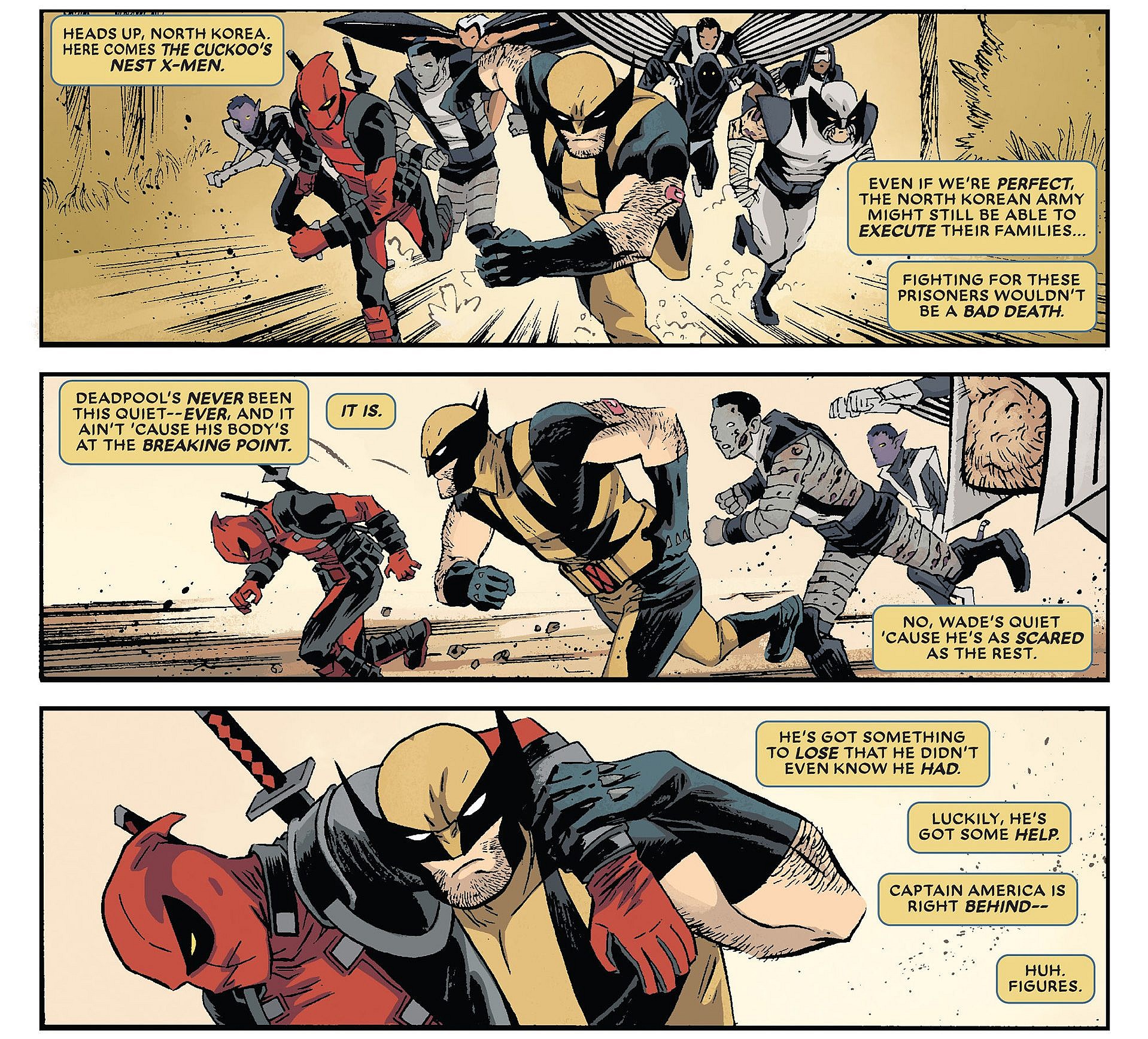
1. The Multiverse Of Madness (Exiles Vol. 1 (2001-2008))
Exiles is neither a Wolverine book, nor a Deadpool book, nor a book in which the two (or versions thereof) spend any significant amount of time with each other.
Rather, Exiles is a book about a group of dimension-displaced, reality-hopping, and primarily mutant heroes who are tasked with preserving the very stability of the Marvel multiverse.
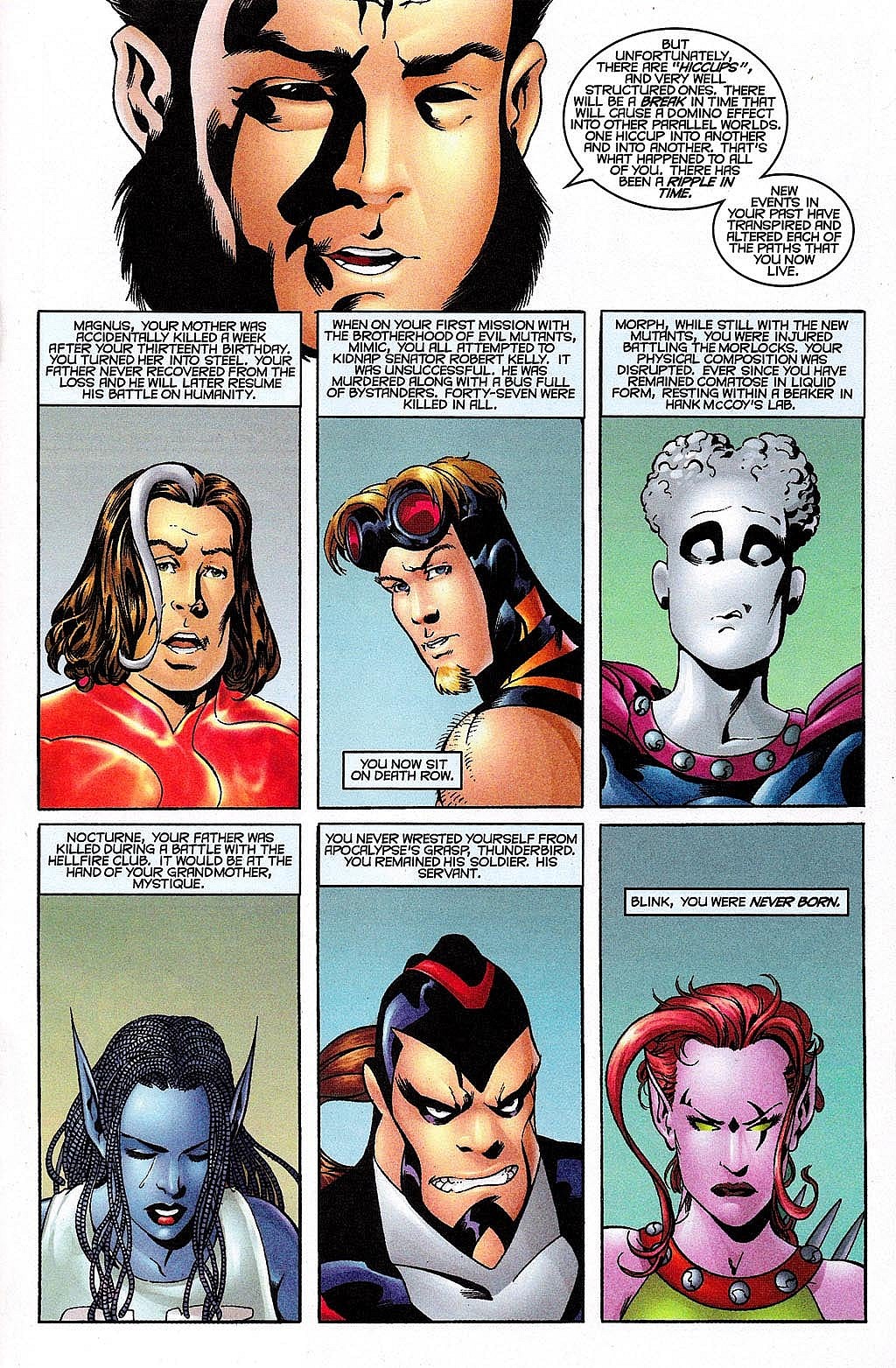
Sound familiar? Almost like Deadpool & Wolverine, if not at the very least the MCU’s TVA, took their entire shtick from the book?
Snarkiness aside, Exiles takes the top spot on this list not just because it’s basically the ‘not-restricted-by-real-life-budget-and-licensing-agreements’ version of Deadpool & Wolverine, but because it’s one of, if not the best Marvel Comics runs of all time.
Helmed by a team of writers including Judd Winnick, Chuck Austen, Tony Bedard, and legendary X-Men scribe Chris Claremont, the series sees an omnipotent being known as the Timebroker recruiting a team of heroes, the titular Exiles, from across the multiverse to help ‘fix’ those universes whose timelines have unexpectedly deviated from their established/presumed paths towards more devastating and apocalyptic ends.
In undertaking the mission, the Exiles come across a number of both new and previously-established characters from across Marvel’s numerous, non-616 realities, including the Squadron Supreme’s Power Princess, the Spider-Man of 2099, and a female version of the Japanese mutant Sunfire.
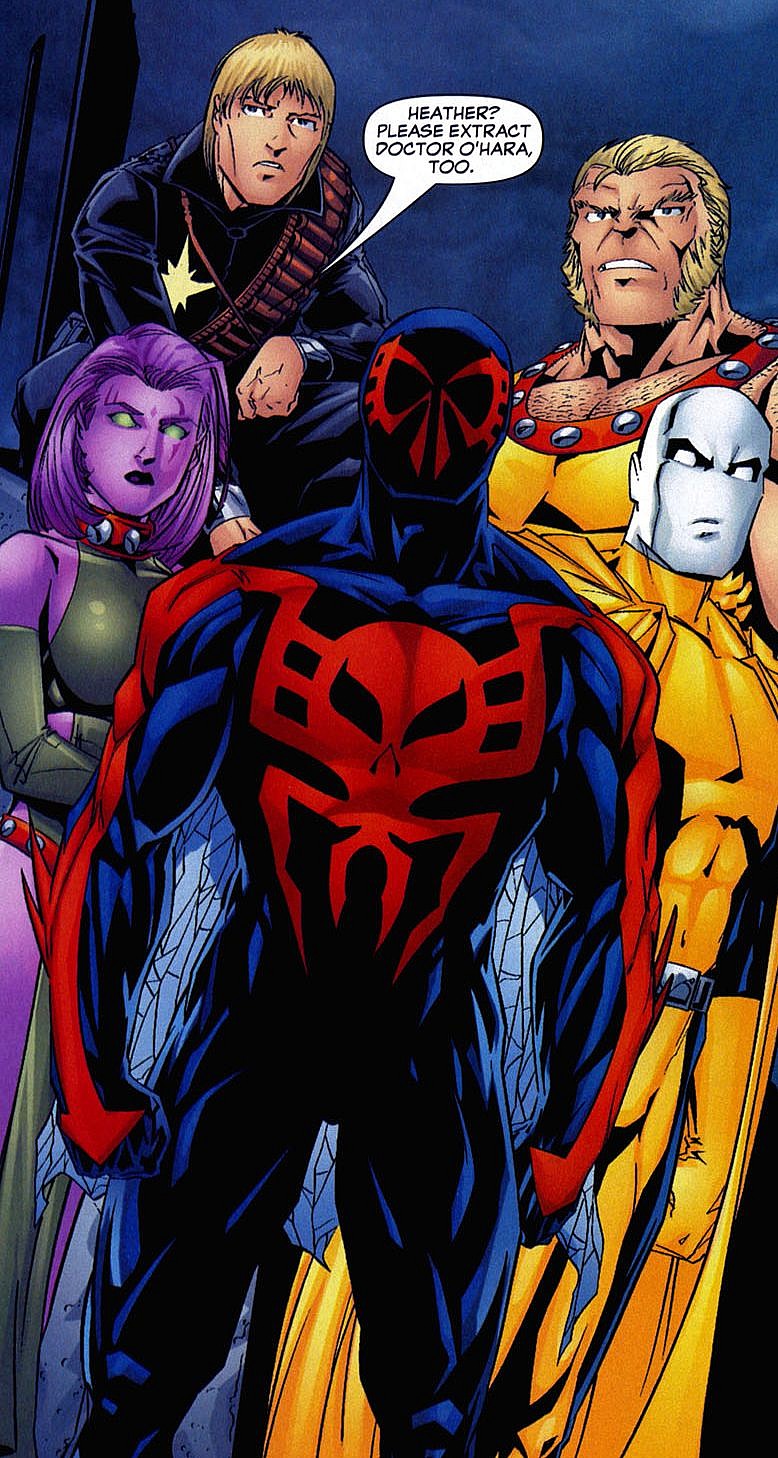
The quintessential ‘multiverse hopping, fan service delivering’ comic book story, Exiles is a must-read not just for anyone who wants more of Deadpool & Wolverine‘s refreshing approach to multiversal storyelling (I mean, what are the Wasteland’s quartet of survivors if not the MCU’s Exiles?), but anyone looking for good comic books period.
(Now, who do I have to talk to about getting the series collected in an omnibus?)
